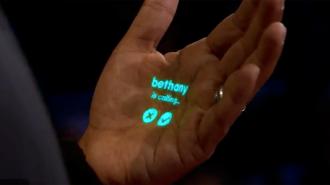An ex-Apple exec who helped invent the iPhone is now trying to invent an “iPhone killer,” and thanks to a leaked video from a TED presentation, we now have our first glimpse at his secretive startup’s creation — but the available video only leads to more questions.
The startup: In 2016, Imran Chaudhri (then-director of design for Apple’s human interface team) and his wife Bethany Bongiorno (then-director for Apple’s operating systems team) quit the company to found their own startup: Humane.
Since then, the company has kept details of what it’s been working on close to its chest, but thanks to job openings posted on Humane’s website and some uncovered patent applications, by 2021, it seemed likely that the startup was developing some sort of personal tech device.
“It’s a new kind of wearable device and platform.”
Imran Chaudhri
Humane’s wearable: The public finally got its first peek behind the curtain this year, on April 21, when footage of Chaudhri demoing Humane tech at the TED2023 conference leaked online. Since then, a few publications, including Inverse, have tracked down the full presentation.
“It’s a new kind of wearable device and platform that’s built entirely from the ground up for artificial intelligence,” Chaudhri tells the audience, according to Inverse. “And it’s completely standalone. You don’t need a smartphone or any other device to pair with it.”
How it works: During the demo, Chaudhri keeps Humane’s wearable in the breast pocket of his shirt, with just the top part peaking out. That bit appears to house a camera lens and sensors that Chaudhri touches during the presentation to interact with the device, and the whole thing looks to be about the size of an earbud charging case.
As for what the device does, Chaudhri demonstrates several functions.
One is language translatation. While pressing his finger on what appears to be a button or sensor on the wearable, Chaudhri speaks briefly to the audience. When he’s finished, there’s a short pause before his voice can be heard emanating from the device, repeating what he just said, but in French — while machine translation has been around for a while, the voice cloning is thanks to a trained AI, according to Chaudhri.
In another clip, he presses on the device and says, “Catch me up.” A Siri-like voice then rattles off a few facts (e.g., “Patrick is coming to tomorrow’s design meeting”) that Chaudhri explains are emails, calendar invites, and messages.
Chaudhri demonstrates how Humane’s wearable can be used to answer a phone call in another video. After the device chimes, he holds his hand in front of it and the words “Bethany is calling” are projected onto his palm, along with an X and check mark. He says, “Hello,” and he and his wife can then engage in a short conversation.
In one last clip, Chaudhri presses on the wearable with one finger while holding a candy bar in front of it with his other hand. He then asks, “Can I eat this?” The voice of the device responds that the treat contains cocoa butter, and that due to his intolerance, he may want to avoid it.
What about… While the leaked footage delivers our best understanding yet of what Humane has been working on, it also raises new questions.
One is how does the device really function? In the available clips, Chaudhri doesn’t ask the device to translate his speech into French, so how did it know that was what he wanted? Was it pre-programmed, off-screen? Is footage from just prior to the demo missing?
It’s also unclear how a person is supposed to “wear” the device if they don’t have a tiny breast pocket. Will it need a fastener on the back?
Is having something projected onto your palm really better than seeing it on a watch screen?
An even bigger question is whether this is something people will want to use. Chaudhri celebrates the experience for being “screenless, seamless, and sensing,” but he often has to push a button to use it, so it’s not exactly seamless, and while it is screenless, we need screens for a lot of things we want to do on the go.
That makes Humane’s wearable seem less like an iPhone killer and more like a (sort of) hands-free supplement to smartphones, and in that respect, it’s not clear how much it can offer that a smartwatch can’t — is having something projected onto your palm really better than seeing it on a watch screen?
The idea of a device built around AI is intriguing, but also frustratingly opaque.
We’ve already seen AIs capable of cloning voices, translating languages, and summing up emails and calendar events, so those aren’t new, but if Humane’s wearable is running the programs locally (perhaps using AI-optimized microchips), that would be an interesting advance as it would mean your personal data isn’t going to the cloud to help train AI models — but we don’t yet know if that’s the case.
The big picture: The full TED presentation is expected to be released on April 22, so it’s possible some of these questions will be answered in the next 24 hours, and even if Humane’s wearable doesn’t seem revolutionary right now, that doesn’t mean it won’t be.
As of March 2023, the company had secured $230 million in funding, and during the latest $100 million round, Microsoft and OpenAI invested, meaning Humane has the backing of a tech powerhouse and arguably the best AI research firm in the world.
For now, it seems we’ll just have to wait a little longer to find out whether the startup actually has an iPhone killer on its hands or simply a niche new gadget in its shirt pocket.
We’d love to hear from you! If you have a comment about this article or if you have a tip for a future Freethink story, please email us at [email protected].






